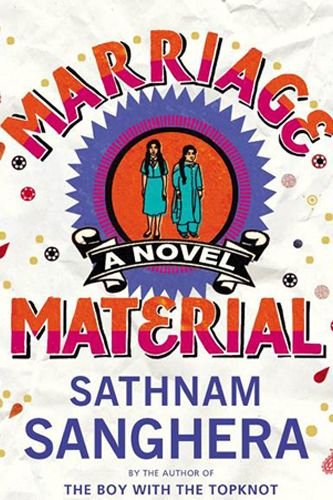Marriage Material
Sathnam Sanghera
|
|
After his father’s death, Arjan Banga is forced to leave his fiancée in London and return home to Wolverhampton in the West Midlands to settle family business. It is 2011. Bains Stores, the family corner shop founded by Arjan’s grandfather, is dilapidated and depressing. Thugs have spray-painted “TALEBAN PEEDO” outside. No matter how many times Arjan tells customers that “as a Sikh I was not expected to marry my cousin or join al-Qaeda”, no one seems to listen. The shutters don’t pull down and the till doesn’t work but Arjan’s mother refuses to give up on the shop, no matter how back-breaking the work or how grim the prospects.
Sathnam Sanghera’s debut novel, Marriage Material, is modelled on Arnold Bennett’s The Old Wives’ Tale (1908), which follows the lives of the Baines sisters, brought up in a draper’s shop. Sanghera’s take is funnier, darker, replete with all the tension that modern “multi-culti” Britain inspires. Marriage Material is told over three generations, starting in the 1950s with Mr Bains, the family patriarch who escaped West Punjab – now Pakistan – after Partition. He arrives in Britain with only a shilling in his pocket and toils in Black Country foundries for several years before saving enough to buy the shop and bring his wife and two daughters, Kamaljit and Surinder, to Britain. They share their house with the shop’s apprentice, Tanvir, a lower-caste man whose family has worked for Mrs Bains’ household in India “for decades”. Kamaljit is awkward, dark and conservative next to her beautiful and slim younger sister. Tanvir is as lost in England as Kamaljit, and his bad accent and embarrassing goof-ups are a constant irritation to Surinder. When the daughters discover their ailing father’s plot to marry them off, Kamaljit couldn’t be more relieved. School was no fun with all the other girls calling her “camel-shit”. Surinder, though, is horrified. She wants to study and become an independent, working woman. Sanghera’s story captures a time of extraordinary changes in Wolverhampton; as Surinder’s teacher puts it, it’s a “town that was enjoying five minutes of fame as Britain’s equivalent of Harlem”. Sanghera flips between the daughters’ story in 1969 and Arjan’s life. Dismayed at the prospect of becoming a “provincial shopkeeper”, he is faced with the existential crisis of all dutiful Asian children. Does he maintain a link with his past and with the identity of his ancestors? Or does he abandon his family’s history and heritage to forge a life of his own? And what does he do with his mother in the process? Arjan is asked by a relative why he doesn’t bring her to London with him and close the shop: “It was one of those questions so big like, ‘Why does God allow war?’, that it was impossible to know where to begin.” When Arjan arrives home after the 2011 riots, Wolverhampton has fallen on hard times and corner stores have been replaced by large shopping centres. Ethnic integration is a more sensitive topic than ever. (His mother says the town is “full of bloody Iraqi now”.) Discrimination, mixed-race marriages and the changing face of Britain appear in both Sanghera’s timelines. As the novel progresses, the stories collide and there are startling revelations, humour and mystery. It is smartly crafted, weaving in droll observations about immigrant life and the defensiveness of south Asians living away from home, while also providing a thoughtful commentary on the casual racism of Britain, the tedium of always being out of place and the complexities of belonging in an increasingly heterogeneous world. Fatima Bhutto | 27 Sept 2013 | FT
|


 Sathnam Sanghera
Sathnam Sanghera